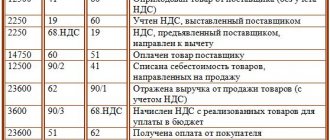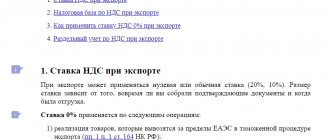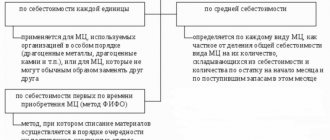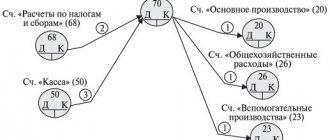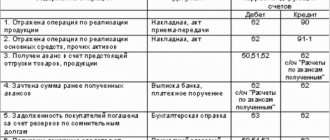Retail trade is the sale of goods for personal use, without subsequent resale. Payment is made in cash or non-cash, using payment cards. The main object of accounting is a unit of goods.
To obtain reliable data on the availability of inventory items, accounting must be timely, continuous, and have uniformity of assessment at all stages - acceptance, movement, disposal. It is required to have up-to-date information on balances at the beginning and end of the billing period.
Primary documents from the product supplier
Primary accounting of goods acceptance in retail is carried out on the basis of supplier data. Receipt of goods and materials from selling companies is accompanied by a set of documents:
- Delivery agreement. The document confirms the intention of the transaction, mandatory conditions and details of the parties. The agreement is signed by legal representatives of organizations or individual entrepreneurs.
- Consignment note form TORG-12. The invoice contains the main shipment indicators in price and quantity equivalent. The invoice contains details of the parties, signatures of responsible persons, and seals of organizations. If the goods are accepted at the supplier's warehouse, the buyer's seal may be absent, subject to the signature of a representative whose authority is confirmed by a power of attorney.
- Invoice. The document is included in the forms subject to the allocation of VAT by the supplier. An invoice “without VAT” is issued by an organization subject to its receipt of tax exemption (Article 145 of the Tax Code of the Russian Federation). A supplier who is not a VAT payer in connection with the use of the simplified tax system or UTII does not provide an invoice.
- TTN and TN. Documents are drawn up when delivering products from the supplier to the buyer by road.
- Certificates, technical documentation. Certification confirms quality compliance with specified standards. The type of certificate depends on the product category.
According to Roskomtorg, the procedure for accepting goods depends on the conditions of acceptance, the presence or absence of documents. When posting products, the quality and quantity of the goods are checked for compliance with the data specified in the accompanying documents and contracts.
Methodological recommendations approved by Roskomtorg letter dated July 10, 1996 No. 1-794/32-5.
Accounting entries when purchasing goods with postpayment
| Account Dt | Kt account | Wiring Description | Transaction amount | A document base |
| 41.01 | 60.01 | Goods received from supplier | Product cost excluding VAT | Sales Invoice |
| 19.03 | 60.01 | Allocation of VAT from the total cost of goods | VAT amount | Sales Invoice |
| 68.02 | 19.03 | Transfer of VAT for reimbursement from the state budget | VAT amount | Invoice, invoice, Purchase book |
| 60.01 | 51 | Repayment of accounts payable | Purchase price of goods | Payment order, bank statement |
Example of transactions upon receipt of goods on prepayment
| Account Dt | Kt account | Wiring Description | Transaction amount | A document base |
| 60.02 | 50.01 | Reflection of prepayment | Prepayment amount | Payment order |
| 41.01 | 60.01 | Posting upon receipt of goods | Product cost excluding VAT | Sales Invoice |
| 19.03 | 60.01 | Allocation of VAT from the total cost of goods | VAT amount | Sales Invoice |
| 68.02 | 19.03 | Transfer of VAT for refund | VAT amount | Invoice, Purchase Book |
| 60.01 | 60.02 | Advance offset | Prepayment amount | Accounting certificate-calculation |
Methods of accounting for a commodity item
In accounting, options for valuing inventory are used, established by PBU 5/01 “Accounting for Inventory”. Enterprises independently determine the method based on the conditions for conducting operations. Organizations or individual entrepreneurs with trading activities use methods of accounting for goods:
- At purchase prices. The accounting method option is similar to transactions accepted in wholesale trade. The system is used in large trading enterprises with significant turnover.
- At selling prices. In accounting, a markup is used, information about which is generated in account 42 “Trade margin”. The system is convenient for use in small retail outlets.
The chosen method for valuing inventory items is approved in the accounting policy of the enterprise. The document is developed by the person responsible for accounting, approved by the head of the company or individual entrepreneur. Despite the absence of the need for individual entrepreneurs to approve accounting policies, a clear position regarding accounting guarantees a high-quality result of the audit by the control authorities.
The organization must ensure financial responsibility, the generation of reliable data with mandatory internal control based on inventories. When forming accounting policy data, it is necessary to take into account that the accounting and tax accounting systems have differences.
Important! In tax accounting, inventory is reflected at purchase prices.
Accounting for receipt of goods at supplier prices
Data on the received asset is recorded in account 41 “Goods”. Along with the purchase price, additional delivery costs arise - non-refundable taxes, transportation costs, customs duties, intermediary services. Enterprises that account for the value of an asset at actual cost include additional expenses in account 41; in other cases, costs are reflected in account 44.
| Purpose of the operation | Documentary basis | Account debit | Account credit |
| Receipt of goods | Invoice TORG-12 | 41 | 60 |
| Allocation of VAT | Seller's invoice | 19 | 60 |
| Reflection of delivery costs, intermediary services | TTN, TN, contracts and acts of service provision | 41, 44 | 60, 76 |
| VAT accounting | Invoice | 19 | 60, 76 |
One of the types of retail trade, taking into account supplier prices, is sales under a commission agreement. The retail seller of goods is a commission agent who carries out trading activities on behalf of and on behalf of the principal. The commission agent enters into a relationship with a retail buyer under a retail purchase and sale agreement on his own behalf.
A special feature of the type of retail under commission agreements is the recording of products in off-balance sheet account 004. The goods are accepted by the commission agent for safekeeping, but remain the property of the principal. The posting and accounting of the commission agent's transactions is carried out at the prices indicated in the shipping invoice issued by the principal.
Receipt of services
We will also consider the receipt of services using an example.
The organization entered into a lease agreement for office space with Business, according to which the monthly rent consists of:
- fixed part - 118,000 rubles;
- variable part, determined monthly based on the cost of utilities.
On March 31, the landlord issued rental documents for March in the amount of RUB 141,600, including VAT 18%.
Reflection in accounting for costs of services
Receipt of services and works from a third-party contractor is reflected in the document Receipt (act, invoice) transaction type Services (invoice) in the section Purchases - Purchases - Receipts (acts, invoices) - button Receipt - Services (invoice).
Please indicate in the form:
- Act No. from - number and date of the act of provision of services, work.
Learn more about setting a default cost account
Postings
Registration of SF supplier
To register an incoming invoice from the lessor, you must indicate its number and date at the bottom of the Receipt document form (act, invoice) , and click the Register .
For more details, see the online course: “Accounting and tax accounting in 1C: Accounting 8th ed. 3 from A to Z"
Test yourself! Take the test:
- Test. Purchasing goods from a separate division with delivery costs included in their price
- Test. Accounting for delivery costs of purchased goods, which are accounted for separately and are not included in their cost
- Test. Typical scheme for purchasing goods in wholesale trade in 1C
Accounting for goods at sales prices
The selling price of a product consists of the acquisition cost or actual cost and trade margin. To record the amount of the markup, account 42 is used. The primary document is a statement - a register of retail prices. The document reflects the amount of the markup and the selling price for all product units. The register form is developed by the enterprise based on the conditions of document flow.
The trade margin allows you to cover the current costs of the enterprise and make a profit from trading activities. After the goods are sold, the markup must be reversed.
| Purpose of the operation | Document | Account debit | Account credit |
| Receipt of goods | Invoice TORG-12 | 41 | 60 |
| Allocation of VAT | Supplier invoice | 41 | 60 |
| Accounting for delivery costs of intermediary and transport companies | TTN, TN, contracts and acts of service provision | 41 | 60, 76 |
| Reflection of trade margins on capitalized inventories | Register of retail prices | 41 | 42 |
| Reflection of other expenses of the enterprise | Invoices, statements, acts | 44 | 10, 70, 69, 60, 76 |
| Receipt of revenue from retail sales | Cashier's check, bank statement | 50, 51 | 90/1 |
| Allocation of VAT | An accountant's certificate for the settlement method or a cash receipt | 90/3 | 68 |
| Write-off of the cost of goods | Summary statements | 90/2 | 41 |
| Write-off of other expenses | Summary statements | 90/2 | 44 |
| Reversal of trade markup (write-off with a negative value) | Register of retail prices | 90/2 | 42 |
An example about the receipt of goods and posting to the warehouse. A trading organization received non-food goods from a supplier in the amount of 300,000 rubles, including VAT in the amount of 50,000 rubles. The markup is set at 50%. The following entries are made in the company's accounting:
- Reception of goods to the warehouse is reflected: Dt 41 Kt 60 in the amount of 250,000 rubles;
- The VAT presented by the supplier is taken into account: Dt 19 Kt 60 in the amount of 50,000 rubles;
- The trade margin was accrued: Dt 41 Kt 42 in the amount of 125,000 rubles.
As a result of the operations performed, the enterprise forms selling prices for goods. The company determines the size of the markup independently, based on business needs and market conditions.
If a situation arises with the need to return purchased goods, the markup is reversed. Returns to the supplier are made in case of detection of hidden defects, receipt of products of inadequate quality or with expiring terms, which was not identified upon acceptance of the goods.
Arrival of goods in 1C
In the interface of the 1C 8.3 program, this document is located on the “Purchases” tab, item “Receipts (acts, invoices)”:
After this we get to the list of documents that have ever been entered. To create a new receipt, you must click on the “Receipt” button, where a menu for selecting the desired type of operation will appear:
Where:
- Goods (invoice) - a document is created only for goods with an accounting account - 41.01;
- Services (act) - reflects only services;
- Goods, services, commission - a universal type of transaction that allows you to reflect commission trade and the receipt of returnable packaging;
- Materials for processing are a special type of operation for accounting for the tolling scheme; in the postings, such receipts will be reflected in off-balance sheet accounts;
- Equipment and Construction Objects - to reflect the receipt of fixed assets on accounts 08.03 and 08.04;
- Leasing services - generates postings to account 76.
Let us consider in detail the receipt of goods and services.
Systematization of goods movement data
Retail trade enterprises, in connection with the introduction of new generation cash register equipment, are using automated accounting. The goods are entered into the accounting program for each incoming batch. Automation allows you to determine the availability of goods in the warehouse in real time, the presence of surplus, and helps prevent misgrading.
When automating processes, you will need online cash registers, a scanner for shading goods, a PC, and software. Automation is used to formulate marketing policies based on current reporting data. The information obtained allows for a timely revaluation of the product group
Change in the cost of remaining products
In the process of accounting, a need arises to change the cost of goods. The reasons for revaluation are: changes in the situation in the supply and demand market, obsolescence of products, proximity to shelf life and other reasons.
When reflecting data on inventory items in sales prices, a change in value affects the amount of the markup. The procedure for changing the size of the markup applies to organizations that use inventory accounting at selling prices. Enterprises are required to create a reserve for impairment of inventory. Changes in product prices are expressed in the form of markdown or revaluation:
- Overestimation of the selling price. When performing a transaction, the amount of the markup increases. The reason for revaluation is the need for prices to correspond to market offers. The following entries are created in accounting: Dt 41 Kt 42 for the amount of the additional price increase.
- Reduced selling price. The amount is reduced by reducing the markup. When conducting an accounting transaction, the amount of the markup is reversed by the amount of the markdown. Accompanied by the entries: Dt 41 Kt 42 red reversal for the amount of reduction.
- A markdown in an amount exceeding the amount of the markup. The cost is reduced through a mark-up; the unaccounted balance is taken into account as part of other expenses. The transaction is recorded: Dt 91 Kt 42 for an amount exceeding the markup. The transaction may result in a price lower than the purchase price.
In the case of quantitative and total accounting of these balances, the basis for revaluation is the consolidated turnover sheets. In the absence of individual data reflection, an inventory of a group of goods is carried out. The audit is carried out by a group of responsible persons appointed by the manager. The composition of the group of inspectors, including financially responsible persons and the chairman of the commission, should not be less than 3 people. Based on the results of operations, adjustments are made to the register of retail prices.
Errors made in retail accounting
Error No. 1. The moment of sale of a retail product is recognized as payment by the buyer with the transfer of ownership. When using acquiring, part of the funds arrives to the current account with a delay (money is in transit). It is considered erroneous to record the sale of goods on the day of receipt of payment according to the bank statement. The goods are considered sold upon issuance of a cash receipt, which is simultaneously recognized as a retail purchase and sale agreement.
Mistake No. 2. Retail companies need systematic inventory taking. Most organizations carry out control measures in the process of conducting business. The position is incorrect even with online transaction accounting. Inventory results in a non-stop process will be distorted; identified shortages or surpluses will appear during the next accounting.
Answers to common questions
Question No. 1. Is it necessary to have separate warehouse accounting of inventories if the enterprise has wholesale and retail trade at the same time?
Enterprises that have the same taxation system can ship from one warehouse. Such an accounting system is possible in the presence of wholesale and large retail (for example, a shopping center), taxed under the general taxation system and accompanied by full accounting.
Question No. 2. Are old price tags used on the sales floor after revaluation or markdown?
After changing the cost of selling a product, the company is obliged to issue a new price tag, replacing the old label. Simultaneous indication of a new and previously used price is not allowed.
Accounting for sales of goods and services
Many companies generate income by selling goods. When selling, you will need to reflect the sold products in accounting. The fact of sale is reflected at the time of shipment or payment. There are some features when reflecting the fulfillment of obligations in wholesale and retail trade.
Sales in wholesale trade
The supplier organization enters into a contract for the sale of goods with the counterparty who buys the goods. In this case, the postings differ based on the option of transferring ownership of the shipped products. Recognition of ownership occurs at the time of sale or after payment. You will need to prepare documents such as a delivery note and an invoice.


